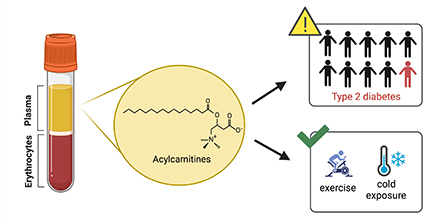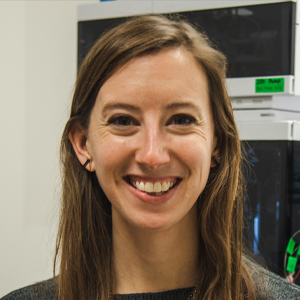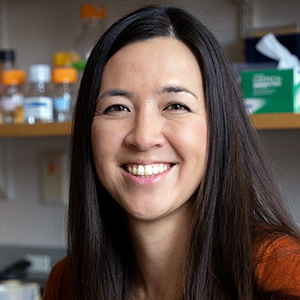Acylcarnitines, a warning signal for Type 2 diabetes
Type 2 diabetes, or T2D, is a chronic disease characterized by insulin resistance that impacts 34.2 million people in the United States. Another 88 million adults are prediabetic, meaning they likely will develop diabetes if they do not receive preventative care. Risk factors for T2D include aging, genetics and obesity. An estimated 89% of adults diagnosed with T2D between 2013 and 2016 were obese.

Irregular lipid metabolism associated with obesity and T2D is termed diabetic dyslipidemia, which includes increased plasma triglycerides and low-density lipoprotein cholesterol. This dyslipidemia occurs in 70% of T2D cases and is associated with higher rates of secondary conditions such as cardiovascular disease. Using mass spectrometry, researchers have found that dyslipidemia is associated with increases in more than 300 lipid species in the plasma, and there is mounting evidence that lipids contribute to T2D as signaling molecules.
Acylcarnitines, one of the lipid classes elevated in plasma with diabetic dyslipidemia, function in transport and signaling. In cells, acylcarnitines are made when a fatty acid is bound to carnitine on the outer mitochondria membrane by the enzyme carnitine palmitoyltransferase 1, or CPT1. Then acylcarnitines are transported into the mitochondria matrix, where they are converted back to free carnitines and fatty acid to be broken down by beta-oxidation for energy production. Acylcarnitines also can evade mitochondrial entry and are exported to the blood plasma.
Plasma acylcarnitines contribute to insulin resistance in obesity and T2D. Mice with genetic loss of CPT1 have lower plasma acylcarnitines and greater insulin sensitivity, while mice with a more active form of CPT1 have higher levels of acylcarnitines and insulin resistance. When Mary-Ellen Harper’s lab at the University of Ottawa treated isolated skeletal muscle cells with acylcarnitines, insulin resistance rapidly developed.
So, why would acylcarnitines signal for insulin resistance?
Plasma acylcarnitines increase in diabetes but also with normal stress such as exercise and cold exposure. Deborah Muoio’s lab at Duke University showed that loss of acylcarnitine processing in muscles leads to exercise intolerance, and work from our lab established that mice with a loss of CPT1 are intolerant to cold. A variant of CPT1 is abundant in Inuit populations of Greenland, Alaska and Canada. Work from our laboratory at the University of Wisconsin–Madison describes how this CPT1 variant is constitutively active, leading to higher acylcarnitine levels, which would be beneficial in response to the cold environment inhabited by the Inuit.
Exertion and cold cause organisms to switch fuel sources rapidly from glucose to lipids. Since insulin stimulates glucose uptake, insulin resistance might be advantageous for the switch to lipids. Acylcarnitine signaling could potentiate insulin resistance to facilitate the fuel transition, but the question is how.
As prediabetes and diabetes prevalence increases, we must identify early warning signs and understand the underlying pathobiology. Acylcarnitines are a piece of the puzzle; questions still loom about their transport and regulation in T2D. Understanding how acylcarnitines signal for insulin resistance and their functional role in normal physiology such as cold stress can hold the key to therapeutic intervention for T2D.

Want more lipid research news?
Check out Lipid Trends, a curated collection of hot picks from the world of lipid research, brought to you by LIPID MAPS.
Enjoy reading ASBMB Today?
Become a member to receive the print edition monthly and the digital edition weekly.
Learn moreGet the latest from ASBMB Today
Enter your email address, and we’ll send you a weekly email with recent articles, interviews and more.
Latest in Science
Science highlights or most popular articles

Genetics studies have a diversity problem that researchers struggle to fix
Researchers in South Carolina are trying to build a DNA database to better understand how genetics affects health risks. But they’re struggling to recruit enough Black participants.

Scientists identify new function of learning and memory gene common to all mammalian brain cells
Findings in mice may steer search for therapies to treat brain developmental disorders in children with SYNGAP1 gene mutations.

From the journals: JBC
Biased agonism of an immune receptor. A profile of missense mutations. Cartilage affects tissue aging. Read about these recent papers.

Cows offer clues to treat human infertility
Decoding the bovine reproductive cycle may help increase the success of human IVF treatments.

Immune cells can adapt to invading pathogens
A team of bioengineers studies how T cells decide whether to fight now or prepare for the next battle.

Hinton lab maps structure of mitochondria at different life stages
An international team determines the differences in the 3D morphology of mitochondria and cristae, their inner membrane folds, in brown adipose tissue.


